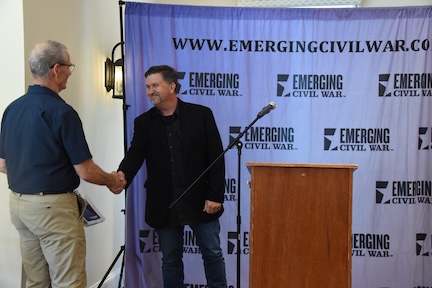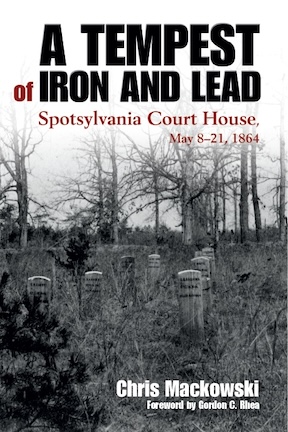Writing Tempest: From Battlefield to Book
In a way, A Tempest of Iron and Lead: Spotsylvania Court House, May 8–21, 1864 (Savas Beatie, 2024), represents a sort of magnum opus for me: the result of fifteen years of Spotsy scholarship. It’s a journey I began with Kris White years ago and continues to this day, with some key players along the way.
Kris and I had written a piece—our first together—about the battle of Second Fredericksburg for Fredericksburg History & Biography and were looking for a next writing project together.
In 2009, John Hennessy, then the chief historian and chief of interpretation at Fredericksburg and Spotsylvania National Military Park (FredSpot), connected Kris and me with Dave Roth at Blue & Gray magazine. That connection led to the first magazine article Kris and I wrote about Spotsy. It was a big deal to us to be able to write about one of the most infamous battles of the war, the fight for the Mule Shoe and the Bloody Angle, for the magazine aimed at the most hard-core Civil War readers. We remain grateful to Dave for the opportunity, and I am especially grateful to John for opening that door in the first place. For that reason, I dedicated Tempest to John.

That same year, Greg Mertz, supervisory historian at FredSpot, invited Kris and me to do five of the park’s six programs for Spotsy’s 145th anniversary (Greg did the sixth, a tour of Laurel Hill, which he had written about for an earlier issue of Blue & Gray). I have been doing battlefield tours of Spotsy ever since, in various capacities for Fred Spot and, most recently, as historian in residence at Stevenson Ridge. It is a battlefield I have spent an immense amount of time on over the subsequent decade and a half. I’m grateful to Greg for that anniversary opportunity. I’m also grateful for the time he took to review the eventual Tempest manuscript and offer comments on its development. Greg has been one of my most important mentors in my development as a historian, and I will forever be indebted to him. (I dedicated an earlier book, Hell Itself: The Battle of the Wilderness, to him.)
Gordon Rhea, the dean of Overland Campaign scholars, has likewise been generous with his time and expertise over the years. Gordon exemplifies the idea of a gentleman and scholar. If John opened the door, Gordon showed me the way, setting the example of excellent Overland scholarship. His book To the North Anna River remains my favorite microtactical study of the Civil War. That book taught me how to run down sources. We’ve since become friends (and colleagues on the board together at the Central Virginia Battlefields Trust), so I’ll admit, I was a little nervous to tell him I was writing a book about a topic that he has written about in such a definitive way. He happily gave me his blessing—and even a foreword for the book! I could not have been more honored.
The next key moment in my relationship with the Spotsy battlefield came in 2011 when I met my now-wife, Jennifer. Jenny’s mother and stepfather, Debbie and Dan Spear, own nearly 90 acres on the battlefield’s eastern front, and the three of them operate their business, Stevenson Ridge, on the property. I basically married into my own battlefield! I thank Dan, Debbie, and Jennifer for giving me free reign to explore, interpret, and share their family’s historically important piece of ground. It’s been fun to open up the undertold story of Spotsylvania’s eastern front, and that in turn has given me a vital familiarity of the larger story of Spotsy I never would have expected.
My involvement with the Central Virginia Battlefields Trust coincided with their opportunity to purchase historically important land at Myer’s Hill. Because that property was not contiguous with the National Park Service’s holdings, the NPS twice passed up opportunities to purchase it. However, preserving that land has opened up that undertold eastern-front story of the second week of the battle in important ways. Because the NPS did not hold much property related to that second week of the battle, that part of the battle has been under-interpreted for nearly a century. As the NPS told the story of Spotsy, the battle sort of ended on May 12 after the Bloody Angle (with a single sign explaining the May 18 fighting). CVBT has preserved land at Harris Farm, along the Po River, and, more recently, at Myer’s Hill. I am grateful to CVBT, and President Tom Van Winkle, for the organization’s ongoing work to expand the story of Spotsy all the way through to the armies’ exit. Local Spotsylvania historian John Cummings has also been a tireless champion for Myer’s Hill’s story and preservation.
Finally, I want to give a shout-out to Jeffry Wert and his book The Heart of Hell: The Soldiers’ Struggle for Spotsylvania’s Bloody Angle. I really like that book a lot, and it gave me the kick in the ass I needed to finally start pulling together the work I’d done on Spotsy over the years. After our first Blue & Gray article, Kris and I continued to write about Spotsy: for Blue and Gray, for Civil War Times and America’s Civil War, and for the American Battlefield Trust’s Hallowed Ground. One of our first books for the Emerging Civil War Series, A Season of Slaughter, was about Spotsy. For years, I envisioned collecting all that work, filling in a few blanks, and putting it into book form. It was Jeff’s book that finally did it for me. I thought, “Here’s a writer I really like who has come into my back yard and written a great book about the battlefield nearest and dearest to me. I need to get off my duff and get the project together. . . .” I am, truly, grateful to Jeff for the inspiration and for setting a high bar to aspire to.
Well, the project as I envisioned it didn’t come to pass quite that way. . . .
But that’s a story for another blog post!
————
A Tempest of Iron and Lead: Spotsylvania Court House, May 8–21, 1864 is available from Savas Beatie here.

The connections you make, many by utter coincidence, are the best! Continuing good fortune on your journey!
I get to meet great folks like you!
ECW has always had an ethos of trying to make opportunities for members of our community because so many people have made opportunities for us. It’s a way to keep doing for others what has been done for us. Speaking for myself, I wouldn’t be where I am if not for the generosity of others.
Chris – sorry, this is off topic – I just wanted to inquire – I have a Civil War history question that I wanted to pose to yourself and/or the group – what is the procedure for doing so? Thanks, Eric